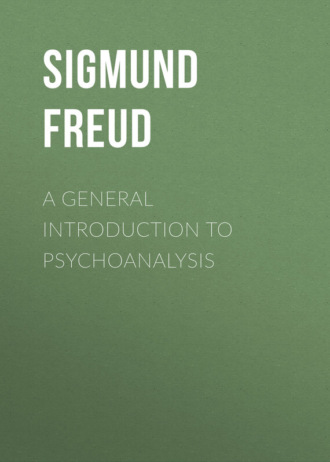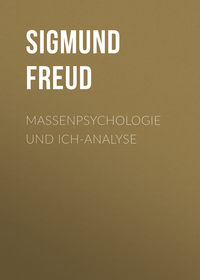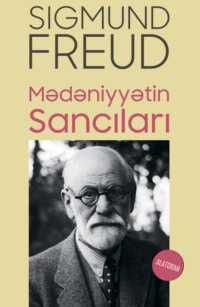 полная версия
полная версияA General Introduction to Psychoanalysis
Before we ask ourselves how we can accommodate this new fact, we must first complete its description. What happens in the case of male patients? Here we might hope to escape the troublesome infusion of sex difference and sex attraction. But the answer is pretty much the same as with women patients. The same relation to the physician, the same over-estimation of his qualities, the same abandon of interest toward his affairs, the same jealousy toward all those who are close to him. The sublimated forms of transference are more frequent in men, the direct sexual demand is rarer to the extent to which manifest homosexuality retreats before the methods by which these instinct components may be utilized. In his male patients more often than in his women patients, the physician observes a manifestation of transference which at first sight seems to contradict everything previously described: a hostile or negative transference.
In the first place, let us realize that the transference occurs in the patient at the very outset of the treatment and is, for a time, the strongest impetus to work. We do not feel it and need not heed it as long as it acts to the advantage of the analysis we are working out together. When it turns into resistance, however, we must pay attention to it. Then we discover that two contrasting conditions have changed their relation to the treatment. In the first place there is the development of an affectionate inclination, clearly revealing the signs of its origin in sexual desire which becomes so strong as to awaken an inner resistance against it. Secondly, there are the hostile instead of the tender impulses. The hostile feelings generally appear later than the affectionate impulses or succeed them. When they occur simultaneously they exemplify the ambivalence of emotions which exists in most of the intimate relations between all persons. The hostile feelings connote an emotional attachment just as do the affectionate impulses, just as defiance signifies dependence as well as does obedience, although the activities they call out are opposed. We cannot doubt but that the hostile feelings toward the physician deserve the name of transference, since the situation which the treatment creates certainly could not give sufficient cause for their origin. This necessary interpretation of negative transference assures us that we have not mistaken the positive or affectionate emotions that we have similarly named.
The origin of this transference, the difficulties it causes us, the means of overcoming it, the use we finally extract from it – these matters must be dealt with in the technical instruction of psychoanalysis, and can only be touched upon here. It is out of the question to yield to those demands of the patient which take root from the transference, while it would be unkind to reject them brusquely or even indignantly. We overcome transference by proving to the patient that his feelings do not originate in the present situation, and are not intended for the person of the physician, but merely repeat what happened to him at some former time. In this way we force him to transform his repetition into a recollection. And so transference, which whether it be hostile or affectionate, seems in every case to be the greatest menace of the cure, really becomes its most effectual tool, which aids in opening the locked compartments of the psychic life. But I should like to tell you something which will help you to overcome the astonishment you must feel at this unexpected phenomenon. We must not forget that this illness of the patient which we have undertaken to analyze is not consummated or, as it were, congealed; rather it is something that continues its development like a living being. The beginning of the treatment does not end this development. When the cure, however, first has taken possession of the patient, the productivity of the illness in this new phase is concentrated entirely on one aspect: the relation of the patient to the physician. And so transference may be compared to the cambrium layer between the wood and the bark of a tree, from which the formation of new tissues and the growth of the trunk proceed at the same time. When the transference has once attained this significance the work upon the recollections of the patient recedes into the background. At that point it is correct to say that we are no longer concerned with the patient's former illness, but with a newly created, transformed neurosis, in place of the former. We followed up this new edition of an old condition from the very beginning, we saw it originate and grow; hence we understand it especially well, because we ourselves are the center of it, its object. All the symptoms of the patient have lost their original meaning and have adapted themselves to a new meaning, which is determined by its relation to transference. Or, only such symptoms as are capable of this transformation have persisted. The control of this new, artificial neurosis coincides with the removal of the illness for which treatment was sought in the first place, namely, with the solution of our therapeutic problem. The human being who, by means of his relations to the physician, has freed himself from the influences of suppressed impulses, becomes and stays free in his individual life, when the influence of the physician is subsequently removed.
Transference has attained extraordinary significance, has become the centre of the cure, in the conditions of hysteria, anxiety and compulsion neuroses. Their conditions therefore are properly included under the term transference neuroses. Whoever in his analytic experience has come into contact with the existence of transference can no longer doubt the character of those suppressed impulses that express themselves in the symptoms of these neuroses and requires no stronger proof of their libidinous character. We may say that our conviction that the meaning of the symptoms is substituted libidinous gratification was finally confirmed by this explanation of transference.
Now we have every reason to correct our former dynamic conception of the healing process, and to bring it into harmony with our new discernment. If the patient is to fight the normal conflict that our analysis has revealed against the suppressions, he requires a tremendous impetus to influence the desirable decision which will lead him back to health. Otherwise he might decide for a repetition of the former issue and allow those factors which have been admitted to consciousness to slip back again into suppression. The deciding vote in this conflict is not given by his intellectual penetration – which is neither strong nor free enough for such an achievement – but only by his relation to the physician. Inasmuch as his transference carries a positive sign, it invests the physician with authority and is converted into faith for his communications and conceptions. Without transference of this sort, or without a negative transfer, he would not even listen to the physician and to his arguments. Faith repeats the history of its own origin; it is a derivative of love and at first requires no arguments. When they are offered by a beloved person, arguments may later be admitted and subjected to critical reflection. Arguments without such support avail nothing, and never mean anything in life to most persons. Man's intellect is accessible only in so far as he is capable of libidinous occupation with an object, and accordingly we have good ground to recognize and to fear the limit of the patient's capacity for being influenced by even the best analytical technique, namely, the extent of his narcism.
The capacity for directing libidinous occupation with objects towards persons as well must also be accorded to all normal persons. The inclination to transference on the part of the neurotic we have mentioned, is only an extraordinary heightening of this common characteristic. It would be strange indeed if a human trait so wide-spread and significant had never been noticed and turned to account. But that has been done. Bernheim, with unerring perspicacity, based his theory of hypnotic manifestations on the statement that all persons are open to suggestion in some way or other. Suggestibility in his sense is nothing more than an inclination to transference, bounded so narrowly that there is no room for any negative transfer. But Bernheim could never define suggestion or its origin. For him it was a fundamental fact, and he could never tell us anything regarding its origin. He did not recognize the dependence of suggestibility upon sexuality and the activity of the libido. We, on the other hand, must realize that we have excluded hypnosis from our technique of neurosis only to rediscover suggestion in the shape of transference.
But now I shall pause and let you put in a word. I see that an objection is looming so large within you that if it were not voiced you would be unable to listen to me. "So at last you confess that like the hypnotists, you work with the aid of suggestion. That is what we have been thinking for a long time. But why choose the detour over reminiscences of the past, revealing of the unconscious, interpretation and retranslation of distortions, the tremendous expenditure of time and money, if the only efficacious thing is suggestion? Why do you not use suggestion directly against symptoms, as the others do, the honest hypnotists? And if, furthermore, you offer the excuse that by going your way you have made numerous psychological discoveries which are not revealed by direct suggestion, who shall vouch for their accuracy? Are not they, too, a result of suggestion, that is to say, of unintentional suggestion? Can you not, in this realm also, thrust upon the patient whatever you wish and whatever you think is so?"
Your objections are uncommonly interesting, and must be answered. But I cannot do it now for lack of time. Till the next time, then. You shall see, I shall be accountable to you. Today I shall only end what I have begun. I promised to explain, with the aid of the factor of transference, why our therapeutic efforts have not met with success in narcistic neuroses.
This I can do in a few words and you will see how simply the riddle can be solved, how well everything harmonizes. Observation shows that persons suffering from narcistic neuroses have no capacity for transference, or only insufficient remains of it. They reject the physician not with hostility, but with indifference. That is why he cannot influence them. His words leave them cold, make no impression, and so the mechanism of the healing process, which we are able to set in motion elsewhere, the renewal of the pathogenic conflict and the overcoming of the resistance to the suppression, cannot be reproduced in them. They remain as they are. Frequently they are known to attempt a cure on their own account, and pathological results have ensued. We are powerless before them.
On the basis of our clinical impressions of these patients, we asserted that in their case libidinous occupation with objects must have been abandoned, and object-libido must have been transformed into ego-libido. On the strength of this characteristic we had separated it from the first group of neurotics (hysteria, anxiety and compulsion neuroses). Their behavior under attempts at therapy confirms this supposition. They show no neurosis. They, therefore, are inaccessible to our efforts and we cannot cure them.
TWENTY-EIGHTH LECTURE
GENERAL THEORY OF THE NEUROSES
Analytical TherapyYOU know our subject for today. You asked me why we do not make use of direct suggestion in psychoanalytic therapy, when we admit that our influence depends substantially upon transference, i.e., suggestion, for you have come to doubt whether or not we can answer for the objectivity of our psychological discoveries in the face of such a predominance of suggestion. I promised to give you a comprehensive answer.
Direct suggestion is suggestion directed against the expression of the symptoms, a struggle between your authority and the motives of the disease. You pay no attention during this process to the motives, but only demand of the patient that he suppress their expression in symptoms. So it makes no difference in principle whether you hypnotize the patient or not. Bernheim, with his usual perspicacity, asserted that suggestion is the essential phenomenon underlying hypnotism, that hypnotism itself is already a result of suggestion, is a suggested condition. Bernheim was especially fond of practising suggestion upon a person in the waking state, and could achieve the same results as with suggestion under hypnosis.
What shall I deal with first, the evidence of experience or theoretic considerations?
Let us begin with our experiences. I was a pupil of Bernheim's, whom I sought out in Nancy in 1889, and whose book on suggestion I translated into German. For years I practised hypnotic treatment, at first by means of prohibitory suggestions alone, and later by this method in combination with investigation of the patient after the manner of Breuer. So I can speak from experience about the results of hypnotic or suggestive therapy. If we judge Bernheim's method according to the old doctor's password that an ideal therapy must be rapid, reliable and not unpleasant for the patient, we find it fulfills at least two of these requirements. It can be carried out much more rapidly, indescribably more rapidly than the analytic method, and it brings the patient neither trouble nor discomfort. In the long run it becomes monotonous for the physician, since each case is exactly the same; continually forbidding the existence of the most diverse symptoms under the same ceremonial, without being able to grasp anything of their meaning or their significance. It is second-rate work, not scientific activity, and reminiscent of magic, conjuring and hocus-pocus; yet in the face of the interest of the patient this cannot be considered. The third requisite, however, was lacking. The procedure was in no way reliable. It might succeed in one case, and fail with the next; sometimes much was accomplished, at other times little, one knew not why. Worse than this capriciousness of the technique was the lack of permanency of the results. After a short time, when the patient was again heard from, the old malady had reappeared, or it had been replaced by a new malady. We could start in again to hypnotize. At the same time we had been warned by those who were experienced that by frequent repetitions of hypnotism we would deprive the patient of his self-reliance and accustom him to this therapy as though it were a narcotic. Granted that we did occasionally succeed as well as one could wish; with slight trouble we achieved complete and permanent results. But the conditions for such a favorable outcome remained unknown. I have had it happen that an aggravated condition which I had succeeded in clearing up completely by a short hypnotic treatment returned unchanged when the patient became angry and arbitrarily developed ill feeling against me. After a reconciliation I was able to remove the malady anew and with even greater thoroughness, yet when she became hostile to me a second time it returned again. Another time a patient whom I had repeatedly helped through nervous conditions by hypnosis, during the treatment of an especially stubborn attack, suddenly threw her arms around my neck. This made it necessary to consider the question, whether one wanted to or not, of the nature and source of the suggestive authority.
So much for experience. It shows us that in renouncing direct suggestion we have given up nothing that is not replaceable. Now let us add a few further considerations. The practice of hypnotic therapy demands only a slight amount of work of the patient as well as of the physician. This therapy fits in perfectly with the estimation of neuroses to which the majority of physicians subscribe. The physician says to the neurotic, "There is nothing the matter with you; you are only nervous, and so I can blow away all your difficulties with a few words in a few minutes." But it is contrary to our dynamic conceptions that we should be able to move a great weight by an inconsiderable force, by attacking it directly and without the aid of appropriate preparations. So far as conditions are comparable, experience shows us that this performance does not succeed with the neurotic. But I know this argument is not unassailable; there are also "redeeming features."
In the light of the knowledge we have gained from psychoanalysis we can describe the difference between hypnotic and psychoanalytic suggestion as follows: Hypnotic therapy seeks to hide something in psychic life, and to gloss it over; analytic therapy seeks to lay it bare and to remove it. The first method works cosmetically, the other surgically. The first uses suggestion in order to prevent the appearance of the symptoms, it strengthens suppression, but leaves unchanged all other processes that have led to symptom development. Analytic therapy attacks the illness closer to its sources, namely in the conflicts out of which the symptoms have emerged, it makes use of suggestion to change the solution of these conflicts. Hypnotic therapy leaves the patient inactive and unchanged, and therefore without resistance to every new occasion for disease. Analytic treatment places upon the physician, as well as upon the patient, a difficult responsibility; the inner resistance of the patient must be abolished. The psychic life of the patient is permanently changed by overcoming these resistances, it is lifted upon a higher plane of development and remains protected against new possibilities of disease. The work of overcoming resistance is the fundamental task of the analytic cure. The patient, however, must take it on himself to accomplish this, while the physician, with the aid of suggestion, makes it possible for him to do so. The suggestion works in the nature of an education. We are therefore justified in saying that analytic treatment is a sort of after-education.
I hope I have made it clear to you wherein our technique of using suggestion differs therapeutically from the only use possible in hypnotic therapy. With your knowledge of the relation between suggestion and transference you will readily understand the capriciousness of hypnotic therapy which attracted our attention, and you will see why, on the other hand, analytic suggestion can be relied upon to its limits. In hypnosis we depend on the condition of the patient's capacity for transference, yet we are unable to exert any influence on this capacity. The transference of the subject may be negative, or, as is most frequent, ambivalent; the patient may have protected himself against suggestion by very special adjustments, yet we are unable to learn anything concerning them. In psychoanalysis we work with the transference itself, we do away with the forces opposing it, prepare the instrument with which we are to work. So it becomes possible to derive entirely new uses from the power of suggestion; we are able to control it, the patient does not work himself into any state of mind he pleases, but in so far as we are able to influence him at all, we can guide the suggestion.
Now you will say, regardless of whether we call the driving force of our analysis transference or suggestion, there is still the danger that through our influence on the patient the objective certainty of our discoveries becomes doubtful. That which becomes a benefit to therapy works harm to the investigation. This objection is most often raised against psychoanalysis, and it must be admitted that even if it does not hit the mark, it cannot be waved aside as stupid. But if it were justified, psychoanalysis would be nothing more than an extraordinarily well disguised and especially workable kind of treatment by suggestion, and we may lay little weight upon all its assertions concerning the influences of life, psychic dynamics, and the unconscious. This is in fact the opinion held by our opponents; we are supposed especially to have "balked into" the patients everything that supports the importance of sexual experiences, and often the experiences themselves, after the combinations themselves have grown up in our degenerate imaginations. We can refute these attacks most easily by calling on the evidence of experience rather than by resorting to theory. Anyone who has himself performed a psychoanalysis has been able to convince himself innumerable times that it is impossible thus to suggest anything to the patient. There is no difficulty, of course, in making the patient a disciple of any one theory, and thus causing him to share the possible error of the physician. With respect to this he behaves just like any other person, like a student, but he has influenced only his intelligence, not his disease. The solving of his conflicts and the overcoming of his resistances succeeds only if we have aroused in him representations of such expectations as can agree with reality. What was inapplicable in the assumptions of the physician falls away during the course of the analysis; it must be withdrawn and replaced by something more nearly correct. By employing a careful technique we seek to prevent the occurrence of temporary results arising out of suggestion, yet there is no harm if such temporary results occur, for we are never satisfied with early successes. We do not consider the analysis finished until all the obscurities of the case are cleared up, all amnestic gaps filled out and the occasions which originally called out the suppressions discovered. We see in results that are achieved too quickly a hindrance rather than a furtherance of analytic work and repeatedly we undo these results again by purposely breaking up the transference upon which they rest. Fundamentally it is this feature which distinguishes analytical treatment from the purely suggestive technique and frees analytic results from the suspicion of having been suggested. Under every other suggestive treatment the transference itself is most carefully upheld and the influence left unquestioned; in analytic treatment, however, the transference becomes the subject of treatment and is subject to criticism in whatever form it may appear. At the end of an analytic cure the transference itself must be abolished; therefore the effect of the treatment, whether positive or negative, must be founded not upon suggestion but upon the overcoming of inner resistances, upon the inner change achieved in the patient, which the aid of suggestion has made possible.
Presumably the creation of the separate suggestions is counteracted, in the course of the cure, by our being continually forced to attack resistances which have the ability to change themselves into negative (hostile) transferences. Furthermore, let me call your attention to the fact that a large number of results of analysis, otherwise perhaps subject to the suspicion that they are products of suggestion, can be confirmed from other unquestionable sources. As authoritative witnesses in this case we refer to the testimony of dements and paranoiacs, who are, naturally far removed from any suspicion of suggestive influence. Whatever these patients can tell us about symbolic translations and phantasies which have forced their way into their consciousness agrees faithfully with the results of our investigations upon the unconscious of transference-neurotics, and this gives added weight to the objective correctness of our interpretations which are so often doubted. I believe you will not go wrong if you give your confidence to analysis with reference to these factors.
We now want to complete our statement concerning the mechanism of healing, by including it within the formulae of the libido theory. The neurotic is incapable both of enjoyment and work; first, because his libido is not directed toward any real object, and second because he must use up a great deal of his former energy to keep his libido suppressed and to arm himself against its attacks. He would become well if there could be an end to the conflict between his ego and his libido, and if his ego could again have the libido at its disposal. The task of therapy, therefore, consists of freeing the libido from its present bonds, which have estranged it from the ego, and furthermore to bring it once more into the service of the ego. Where is the libido of the neurotics? It is easy to find; it is bound to the symptoms which at that time furnish it with the only available substitute satisfaction. We have to become master of the symptoms, and abolish them, which is of course exactly what the patient asks us to do. To abolish the symptoms it becomes necessary to go back to their origin, to renew the conflict out of which they emerged, but this time with the help of motive forces that were originally not available, to guide it toward a new solution. This revision of the process of suppression can be accomplished only in part by following the traces in memory of the occurrences which led to the suppression. The decisive part of the cure is accomplished by means of the relationship to the physician, the transference, by means of which new editions of the old conflict are created. Under this situation the patient would like to behave as he had behaved originally, but by summoning all his available psychic power we compel him to reach a different decision. Transference, then, becomes the battlefield on which all the contending forces are to meet.











